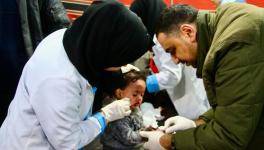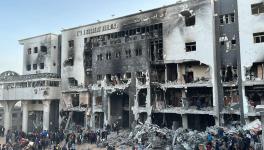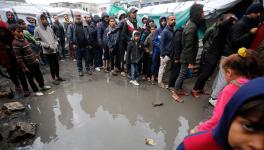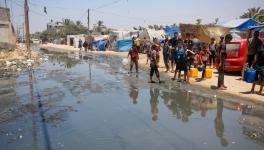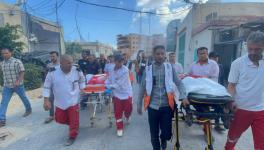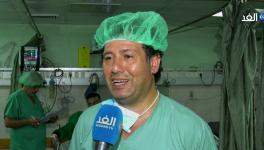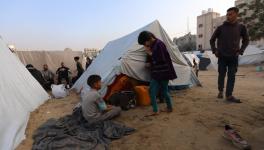Wars Fuel Rise of Resistant Superbugs in Global South

Destroyed Ukrainian tank near Severodonetsk. (Photo: via Vyacheslav Yakovenko/Rossa Primavera News Agency)
In global health circles, antimicrobial resistance (AMR) has long been recognized as a ticking time bomb. With the potential to kill as many as 10 million people each year by 2050, it demands the same sombre confrontation as the threat of nuclear weapons, argues Nicoletta Dentico, lead of the global health program at the Society for International Development (SID). Yet, despite formal recognition by the World Health Organization (WHO), AMR remains inadequately addressed. When they do happen, discussions often focus narrowly on research and development (R&D) of new antibiotics, ignoring a host of other factors fueling the spread of drug-resistant pathogens in a capitalist world.
“Of course, we need new drugs,” Dentico agrees, “but we can’t look at these problems from an R&D perspective alone—it’s far too limited to be realistic.”
AMR occurs when germs develop resistance to drugs designed to combat them, a process strongly associated with human activities such as industrial meat production, agricultural practices, and the improper disposal of e.g. pharmaceutical waste and heavy metals. High-income countries still frequently export this waste to low- and middle-income ones, fueling the process while seemingly expressing concerns about the dangers posed, as recognized in earlier analyses by SID and the AMR Think-Do-Tank.
Armed conflicts: an action inducer of AMR
Waste, however, is not the only thing the Global North likes to drop on the Global South that fuels AMR. Bombs and weapons deployed in armed conflicts are significant catalyzers for the process. Heavy metals like zinc, lead, mercury, and materials like antimony, commonly used in war materials, act as “action inducers” of AMR, Dentico explains. Once disseminated into the environment, they not only facilitate the spread of resistant genes but strengthen them. “When you explode a tank, all the shrapnel, all the splinters of metal contaminate the environment,” she says. These are the same materials used to manufacture missiles, guns, vehicles, and primers deployed in Israel’s ongoing genocide in Gaza, materials that will undoubtedly leave a profound and long-lasting impact on public health in the region.
The situation worsens when healthcare systems themselves become targets. This pattern has appeared in previous conflicts that spurred research into the connection between war and AMR, including recent wars in Iraq. “As bombings, unsafe living conditions, and the destruction of public infrastructure became commonplace in Iraq, these factors overlapped with a catastrophic worsening of AMR, potentially the result of a broader ecology of war that has been decades in the making,” concluded Antoine Abou Fayad and other researchers in 2022. Iraq’s healthcare system remains far from recovery following its devastation, a scenario that is now unfolding—in an even more dramatic way—in Palestine.
In Gaza, hospitals, laboratories, and rehabilitation facilities have been deliberately targeted by Israeli armed forces. The destruction of physical healthcare infrastructure has been compounded by a campaign to eliminate Palestinian health workers, with over 1,100 killed by the beginning of January 2025. Without hospitals, laboratories, or health workers, the Strip is at risk of becoming an ideal ground for the breeding and spread of resilient pathogens. With corpses still left under the rubble, Gaza has become a potential microbiological bomb—and this should be recognized as another consequence of the genocide, Dentico insists.
The full health impact of the Gaza genocide is yet to unfold, but clear links to the spread of drug-resistant bacteria in the region are already visible. Following the Great March of Return in 2018-2019, public health experts observed widespread resistance to select antibiotics in Gaza. Efforts to address the issue in all Palestine, including a national plan to counter AMR drafted by the Palestinian Ministry of Health, were certainly undermined by Israel’s ongoing obstructions of medical supplies and clean water.
Since October 2023, water quality and drug availability in Gaza have deteriorated even further. “Injuries are happening in such a polluted context that infections are recurring more and amputations have to take place,” explains Dentico. Many of these injuries, caused by burns or explosions, are likely to be heavily contaminated with bacteria and require extensive post-operative procedures like physiotherapy or isolation—resources that are now entirely unattainable.
While Gaza already stands out as the most devastating example in West Asia of how armed conflict can drive AMR, other countries in the region have faced similar experiences. Syria and Afghanistan, in addition to Iraq, have endured conflicts that could yield comparable outcomes. In fact, over the years, there has been a “stratification of war and armed conflicts in that area,” Dentico explains, leaving the region highly susceptible to becoming a hub for highly resistant bacteria in the future.
Health is an argument for global peace
The threat goes beyond Asia, however, with conflicts in other regions bringing similar dangers. For example, the destruction of dams and industrial complexes in Ukraine could create additional breeding grounds for pathogens, Dentico warns. “Especially because for a long time, these lands, these territories will not be attended by anyone.”
The spread of AMR as a consequence of ongoing wars should serve as a universal wake-up call. To fully grasp the urgency of the situation, Dentico suggests, we could imagine that bacteria themselves are provoking humanity to rethink its actions. In this picture, she continues, “they are provoking us to think and act differently, and to stop justifications of war, because there is already huge anthropogenic devastation on the planet,” she explains.
“We don’t need war; the war humankind is already waging against the planet is more than enough,” Dentico states. Instead, she emphasizes that existing and future research into the connections between AMR and war should be used as powerful arguments to change route and steer the world toward a path of peace.
People’s Health Dispatch is a fortnightly bulletin published by the People’s Health Movement and Peoples Dispatch. For more articles and subscriptions to People’s Health Dispatch, click here.
Get the latest reports & analysis with people's perspective on Protests, movements & deep analytical videos, discussions of the current affairs in your Telegram app. Subscribe to NewsClick's Telegram channel & get Real-Time updates on stories, as they get published on our website.









